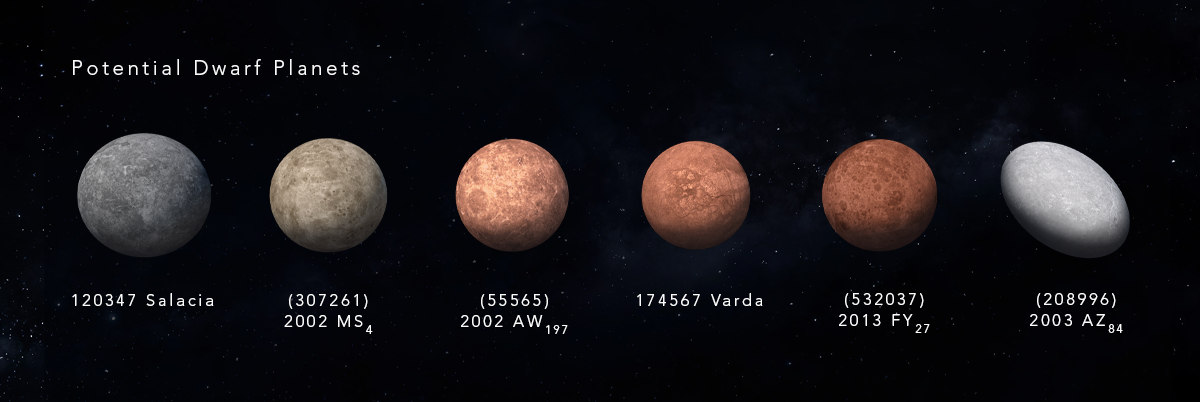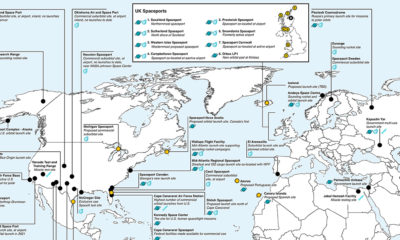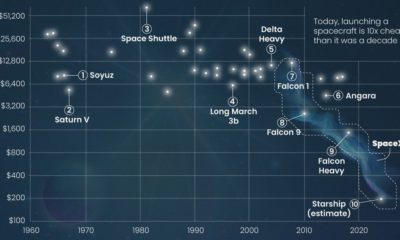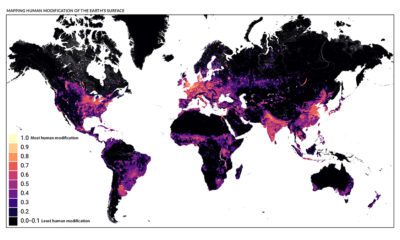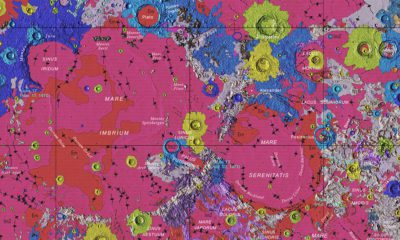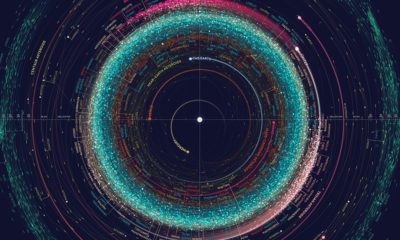For starters, not only is Pluto smaller than any other planet in the solar system, but it’s also smaller than Earth’s moon. It also has an extremely low gravitational pull at only 0.07 times the mass of the objects in its orbit, which is just a fraction of the Moon’s own strength. At the same time, Pluto’s surface resembles that of terrestrial planets such as Mars, Venus or the Earth, yet its nearest neighbors are the gaseous Jovian planets such as Uranus or Neptune. In fact, Pluto’s orbit is so erratic that it led many scientists to initially believe that it originated elsewhere in space and the Sun’s gravity pulled it in. These qualities have challenged the scientific view of Pluto’s status as a planet for years. It wasn’t until the discovery of Eris in 2005, one of many increasingly identified trans-Neptunian objects (objects beyond the planet Neptune), that the International Astronomical Union (IAU) defined criteria for classifying planets. With Eris and other trans-Neptunian objects sharing similar characteristics with Pluto, the definition for dwarf planets was created, and Pluto got downgraded in 2006. So what are dwarf planets, how do they differ from “true” planets and what are their characteristics?
The History of Dwarf Planets
A dwarf planet is a celestial body that almost meets the definition of a “true” planet. According to the IAU, which sets definitions for planetary science, a planet must: Dwarf planets, along with not being moons or satellites, fail to clear the neighborhoods around their orbits. This is the primary reason why Pluto lost its status: because it shares part of its orbit with the Kuiper belt, a dense region of icy space bodies. Based on this definition, the IAU has recognized five dwarf planets: Pluto, Eris, Makemake, Haumea, and Ceres. There are four more planetary objects*, namely Orcus, Sedna, Gonggong and Quaoar, that the majority of the scientific community recognize as dwarf planets. Six more could be recognized in the coming years, and as many as 200 or more are hypothesized to exist in the Outer Solar System in the aforementioned Kuiper belt. Ceres is the earliest known and smallest of the current category of dwarf planets. Previously classified as an asteroid in 1801, it was confirmed to be a dwarf planet in 2006. Ceres lies between Mars and Jupiter in the asteroid belt, and it is the only dwarf planet that orbits closest to Earth. Here is a brief introduction to the most recognized dwarf planets:
Interesting Facts about Dwarf Planets
Here are a few interesting facts about the dwarf planets discovered in our solar system:
Ceres loses 6kg of its mass in steam every second
The Herschel Space Telescope observed plumes of water vapor shooting up from Ceres’ surface; this was the first definitive observation of water vapor in the asteroid belt. This happens when portions of Ceres’ icy surface warm up and turn into steam.
A day on Haumea lasts 3.9 hours
Haumea has a unique appearance due to its rotation, which is so rapid that it compresses the planet into an egg-like shape. Its rotational speed and collisional origin also make Haumea one of the densest dwarf planets discovered to date.
Makemake was named three years after its discovery in 2005
Makemake’s discovery close to Easter influenced both its name and nickname. Before being named after the creator of humanity and god of fertility in the mythos of the Rapa Nui (the native people of Easter Island), Makemake was nicknamed “Easter bunny” by its discoverer Mike Brown.
Eris was once considered for the position of the 10th planet
Eris is the most massive dwarf planet in the solar system, exceeding Pluto’s mass by 28%. As such, it was a serious contender to become the tenth planet but failed to meet the criteria set out by the IAU.
Pluto is one-third ice
The planet’s composition makes up two-thirds rock and one-third ice, mostly a mixture of methane and carbon dioxide. One day on Pluto is 153.6 hours, approximately 6.4 Earth days, making it one of the slowest rotating dwarf planets.
Exploratory Missions and New Planets on the Horizon
With newer technology rapidly available to the scientific community and new exploratory missions getting more data and information about trans-Neptunian objects, our understanding of dwarf planets will increase. Nestled in the asteroid belt between Mars and Jupiter, the asteroid Hygiea remains a controversy. Hygiea is the fourth largest object in the asteroid belt behind Ceres, Vesta, and Pallas and ticks all the boxes necessary to be classified as a dwarf planet. So what’s holding back Hygiea’s confirmation as a dwarf planet? The criterion for being massive enough to form a spherical shape is in contention; it remains unclear if its roundness results from collision/impact disruption or its mass/gravity. Along with Hygiea, other exciting dwarf planets could be soon discovered. Here is a quick rundown of some serious contenders:
Discovered in 2004, it is a trans-Neptunian object in the Kuiper belt, approximately 850 kilometers in diameter. As of 2018, it is located about 44.8 astronomical units from the Sun. Salacia’s status is in contention because its planetary density is arguable. It is uncertain if it can exist in hydrostatic equilibrium. With an estimated diameter of 934±47 kilometers, 2002 MS4 is comparable in size to Ceres. Researchers need more data to determine whether 2002 MS4 is a dwarf planet or not. Discovered at the Palomar Observatory in 2002, it has a rotation period of 8.8 hours, a moderately red color (similar to Quaoar) and no apparent planetary geology. Its low albedo has made it difficult to determine whether or not it is a dwarf planet. Varda takes its name after the queen of the Valar, creator of the stars, one of the most powerful servants of almighty Eru Iluvatar in J. R. R. Tolkien’s fictional mythology. Varda’s status as a dwarf planet is uncertain because its size and albedo suggest it might not be a fully solid body. This space object has a surface diameter of about 740 kilometers. It orbits the Sun once every 449 years. Researchers need more data on the planet’s mass and density to determine if it is a dwarf planet or not. It is approximately 940 kilometers across its longest axis, as it has an elongated shape. This shape is presumably due to its rapid rotation rate of 6.71 hours, similar to that of other dwarf planets like Haumea. Like Varda, it remains unknown if this object has compressed into a fully solid body and thus remains contentious amongst astronomers regarding its planetary status. *Note: The IAU officially recognizes five dwarf planets. We include four additional dwarf planets widely acknowledged by members of the scientific community, especially amongst leading planetary researchers like Gonzalo Tancredi, Michael Brown, and William Grundy. There are many more potential dwarf planets not listed here that remain under investigation. on Even while political regimes across these countries have changed over time, they’ve largely followed a few different types of governance. Today, every country can ultimately be classified into just nine broad forms of government systems. This map by Truman Du uses information from Wikipedia to map the government systems that rule the world today.
Countries By Type of Government
It’s important to note that this map charts government systems according to each country’s legal framework. Many countries have constitutions stating their de jure or legally recognized system of government, but their de facto or realized form of governance may be quite different. Here is a list of the stated government system of UN member states and observers as of January 2023: Let’s take a closer look at some of these systems.
Monarchies
Brought back into the spotlight after the death of Queen Elizabeth II of England in September 2022, this form of government has a single ruler. They carry titles from king and queen to sultan or emperor, and their government systems can be further divided into three modern types: constitutional, semi-constitutional, and absolute. A constitutional monarchy sees the monarch act as head of state within the parameters of a constitution, giving them little to no real power. For example, King Charles III is the head of 15 Commonwealth nations including Canada and Australia. However, each has their own head of government. On the other hand, a semi-constitutional monarchy lets the monarch or ruling royal family retain substantial political powers, as is the case in Jordan and Morocco. However, their monarchs still rule the country according to a democratic constitution and in concert with other institutions. Finally, an absolute monarchy is most like the monarchies of old, where the ruler has full power over governance, with modern examples including Saudi Arabia and Vatican City.
Republics
Unlike monarchies, the people hold the power in a republic government system, directly electing representatives to form government. Again, there are multiple types of modern republic governments: presidential, semi-presidential, and parliamentary. The presidential republic could be considered a direct progression from monarchies. This system has a strong and independent chief executive with extensive powers when it comes to domestic affairs and foreign policy. An example of this is the United States, where the President is both the head of state and the head of government. In a semi-presidential republic, the president is the head of state and has some executive powers that are independent of the legislature. However, the prime minister (or chancellor or equivalent title) is the head of government, responsible to the legislature along with the cabinet. Russia is a classic example of this type of government. The last type of republic system is parliamentary. In this system, the president is a figurehead, while the head of government holds real power and is validated by and accountable to the parliament. This type of system can be seen in Germany, Italy, and India and is akin to constitutional monarchies. It’s also important to point out that some parliamentary republic systems operate slightly differently. For example in South Africa, the president is both the head of state and government, but is elected directly by the legislature. This leaves them (and their ministries) potentially subject to parliamentary confidence.
One-Party State
Many of the systems above involve multiple political parties vying to rule and govern their respective countries. In a one-party state, also called a single-party state or single-party system, only one political party has the right to form government. All other political parties are either outlawed or only allowed limited participation in elections. In this system, a country’s head of state and head of government can be executive or ceremonial but political power is constitutionally linked to a single political movement. China is the most well-known example of this government system, with the General Secretary of the Communist Party of China ruling as the de facto leader since 1989.
Provisional
The final form of government is a provisional government formed as an interim or transitional government. In this system, an emergency governmental body is created to manage political transitions after the collapse of a government, or when a new state is formed. Often these evolve into fully constitutionalized systems, but sometimes they hold power for longer than expected. Some examples of countries that are considered provisional include Libya, Burkina Faso, and Chad.
